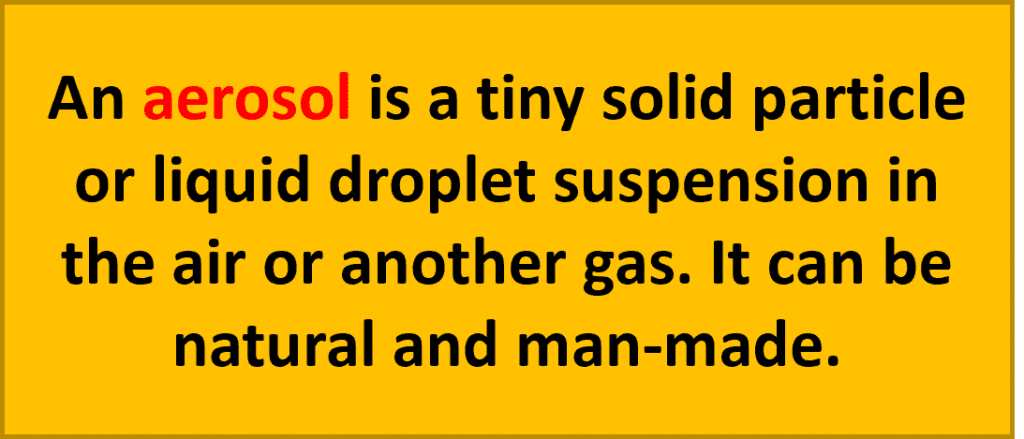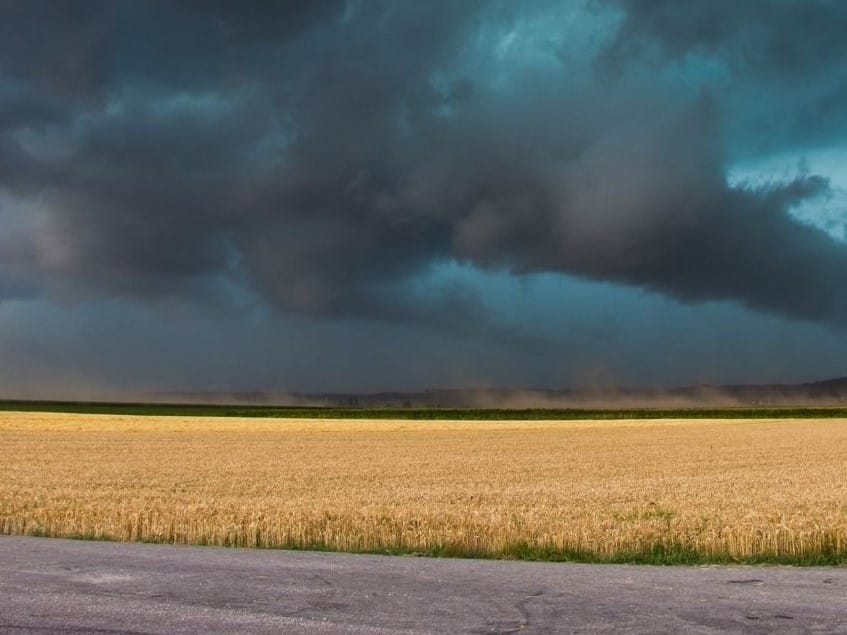An aerosol is a tiny solid particle or liquid droplet suspended in the air or another gas. Aerosols may be both natural and man-made. Natural aerosols include fog or mist, dust, sea salt, forest exudates, and geyser steam. On the other hand, pollution from automobiles and industries is a significant man-made source of aerosols.
In addition, droplets and aerosols are not the same things. When compared to droplets, aerosolized particles are infinitesimal. Droplets fall to the ground rapidly, whereas aerosols can travel for hours on air currents.
This article covers the definition of aerosol along with its sources and uses.

Table of Contents
Aerosol Definition?
The term “aerosol” refers to stuff that is “floating” in the air and is a suspension (a mixture in which solid or liquid or combined solid-liquid particles are suspended in a fluid). Aerosols are technically suspensions of small solid particles or liquid droplets in a gas. Aerosols may be found in a variety of forms in urban habitats, including:
- Dust
- Tobacco smoke
- Spray mist from aerosol spray cans
- Car exhaust contains soot or fumes.
- Smoke,
- Maritime haze
- Smog
Furthermore, particles, along with well-known greenhouse gases like carbon dioxide, are produced by the combustion of fossil fuels, so vehicles, aircraft, power plants, and industrial activities all create particles that can accumulate in the atmosphere.
Sulfur dioxide is produced in massive amounts by the combustion of fossil fuels, where it mixes with water vapor and other gases in the atmosphere to form sulfate aerosols. Biomass burning, a common method of clearing land and consuming farm waste, emits smoke that is largely made up of organic carbon and black carbon [Ref-1].
Simple Definition of Aerosol
An aerosol is a suspension of tiny particles or droplets in the air. These particles can be solid or liquid, and they are small enough to remain suspended in the air for a long time. Aerosols can be natural, like sea spray or volcanic ash, or they can be human-made, like spray paint or hairspray. Aerosols can have different effects on the environment and human health depending on their composition and size.
Real-Life Examples of Aerosols
Aerosols are tiny particles or droplets suspended in the air. Here are some real-life examples of aerosols:
- Fog: When water droplets are suspended in the air, they form fog, which is an example of an aerosol.
- Smoke: Smoke from a fire is made up of tiny particles and gases that form an aerosol.
- Perfume: When you spray perfume, the tiny droplets of fragrance that are released into the air are an example of an aerosol.
- Air pollution: Many types of air pollution, such as smog or vehicle exhaust, are made up of aerosols.
- Ocean spray: When waves crash against the shore, they create tiny droplets of seawater that become aerosols in the air.
- Hair spray: When you spray hair spray, the fine mist of particles that are released is an example of an aerosol.
- Dust: Dust particles that are suspended in the air are considered to be aerosols.
- Pollen: Pollen grains from plants can also become airborne and form an aerosol, which can trigger allergies in some people.
- Insecticide spray: When you use an insecticide spray to kill insects, the fine mist of particles that are released is also an example of an aerosol.
Overall, aerosols can be found in many different environments and can have both natural and human-made sources.
Aerosols in Medical Terms
- Respiratory droplets: When a person talks, coughs, or sneezes, tiny droplets of saliva and mucus are expelled from their mouth and nose. These droplets can contain viruses, bacteria, or other pathogens, and if someone nearby inhales them, they can become infected. Respiratory droplets are an example of an aerosol in medical terms.
- Nebulizers: Nebulizers are medical devices that convert liquid medication into a fine mist or aerosol that can be inhaled into the lungs. This is a common treatment for respiratory conditions like asthma or chronic obstructive pulmonary disease (COPD).
- Oxygen therapy: Oxygen therapy can also involve the use of aerosols. For example, a patient with a respiratory condition may use a mask or nasal cannula that delivers oxygen in the form of an aerosol.
- Anaesthesia: During surgery, anesthesiologists may use aerosols to deliver medications to help the patient sleep or to control pain.
- Bronchoscopy: Bronchoscopy is a medical procedure that involves inserting a small tube into the lungs to examine the airways or take a tissue sample. During the procedure, a small amount of saline solution may be sprayed into the airways to help visualize the tissue.
Overall, aerosols play an important role in many medical procedures and can have both beneficial and harmful effects on human health depending on their composition and size.
Uses of Aerosols
Aerosols are used in a variety of cosmetics, including hairspray, deodorant sprays, foaming agents, sprays, and sunscreens. Furthermore, they are utilized in medicine as disinfectants, inhalers, anaesthetic preparations, and so on.
Summary
Aerosols are tiny particles in the air that can be formed when several forms of fossil fuels — coal, petroleum, wood, and biofuels — are burned in various ways. Pollution from vehicles and industry is a substantial man-made source of aerosols. They are used in a wide range of products, from mass-market goods such as cosmetics and household products
Frequently Asked Questions
| Question | Answer |
|---|---|
| What are aerosols? | Aerosols are tiny particles or droplets that are suspended in the air. |
| What are some common sources of aerosols? | Aerosols can come from natural sources like sea spray or volcanic eruptions, or from human activities like spray painting or using aerosolized cleaning products. |
| What is an example of a medical application of aerosols? | Aerosolized medications can be delivered to the lungs using nebulizers or inhalers to treat respiratory conditions like asthma or chronic obstructive pulmonary disease (COPD). |
| What are some environmental impacts of aerosols? | Aerosols can affect the climate by reflecting or absorbing sunlight, and they can also contribute to air pollution and reduce visibility. |
| How are aerosols used in industry? | Aerosols are used in industrial applications such as spray painting, lubrication, and cleaning. |
| What is an example of an aerosolized pesticide? | An example of an aerosolized pesticide is a can of insecticide spray used to kill insects in and around the home. |
| How do aerosol fire extinguishers work? | Aerosol fire extinguishers work by releasing a fine mist of extinguishing agent that suppresses the fire by cooling and smothering the flames. |
More Related Questions
1. What is aerosol in chemistry?
In chemistry, An aerosol is a gaseous suspension of tiny solid or liquid particles. Smoke, fog, and mist are all examples of aerosols. According to the book “Environmental Organic Chemistry for Engineers, 2017,” an aerosol is a suspension of liquid or solid particles in a gas with particle sizes ranging from 10-9 μm to 10-4 μm.
2. Are aerosols harmful to humans?
As aerosol cans are under pressure, they can explode if perforated or incorrectly depressurized. Aerosol cans also commonly include ecologically hazardous substances, such as insecticides, which can affect the environment without directly depleting the ozone layer. In addition, leftover materials in aerosol cans are typically considered hazardous trash and must be managed as such.
More Interesting Links
Reference
- Ref-1: https://earthobservatory.nasa.gov/features/Aerosols
- BCl3 Lewis Structure in four simple steps - November 1, 2023
- PH3 Lewis Structure in four simple steps - October 8, 2023
- PF3 Lewis structure in four simple steps - September 24, 2023



